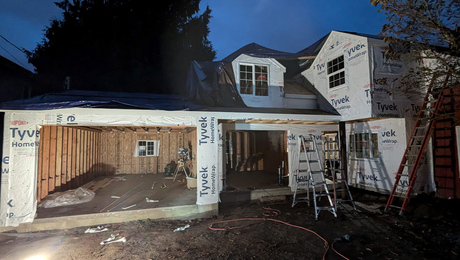Hi,
This is my first time installing a wooden 1 1/2″ thick T/G floor pine floor, its for the workshop in a double garage. Just wanted to run my final plan via some of you with more experience than I.
I’m located in Ontario Canada, so it gets cold. Firstly I’m putting down a 6mm moisture barrier then a frame around the room using 8″ sleepers ripped to level out the slope in the existing concrete floor. Then lay sleepers at 16″ centres between the frame which will again be ripped to level out the slope of the concrete. I’ll place shims every 12″ where the sleepers dont meet with the concrete and use string line with level to get a level surface as the sleepers are being layed.
Apparently blocking is not necessary but can help during the construction process so I plan on putting it down when necessary.
Is it absolutely necessary to tapcon the sleeper to the concrete? There will be some fairly heavy equipment placed on the floor when complete.
Will the shims stay in place by themselves or do they need to be glued to the bottom of the sleepers.
Anything else?
Thanks,
Wayne
Edited 4/7/2007 4:55 pm ET by waynew















Replies
Another question that just came to mind: Would it be better to leave a small gap between the sleepers and concrete along the whole length for shiming or get as close a fit as possible to the concrete resting directly on the concrete as much as possible.
Regards.
i don't think you need the tap cons... or that many shims... i'd cut it close and the put a bead of construction glue (liquid nails) on the cut edge of the sleeper... as long as you are close the glue will fill tha gaps... with 1 1/2" t&g even with heavy equipment... 24oc is prob enough... 16" might be overkill
good luck
p
Thanks Rez and P,Since posting the question I've actually made a start on the floor. One addition to the plan is that I've layed some of that felt tar paper over the moisture barrier.Im about a 1/3rd finished and whilst the structure seems strong enough I'm now thinking it needs some of those metal brackets to brace it to the concrete, not too many just a few here and there.I found that the concrete floor is sloping all over the place so its quite the job getting each sleeper to fit snug to the concrete and at the same time dead level on the surface. The way I do it is to cut the sleeper to the correct length, try to trim the bottom of the sleeper to the shape of the floor using the bandsaw then snap a chalk line across the sleeper and rip level using the saw, it seems to work buts its slow going. Most of the sleepers still need some shimming but shaping the bottoms seems to cut down the need for so many.Regards,Wayne
Greetings waynew-
This post, in response to your question, will bump the thread through the 'recent discussion' listing again which will increase it's viewing.
Perhaps it will catch someone's attention that can help you with advice.
Cheers
Parolee # 53804
Well, let's run this thru once again...
bump
Parolee # 53804
Line levels are pretty worthless, unless the line in tied off VERY tight. Even so, It would be much simpler and more accurate, using a builder's level to shoot the shim points. An alternate method is to tie off you line tight, then put a common size block under each end of the string, thereby suspending it above the sleeper to be shimmed. Then you can take a like sized block and use it as a guage, placing it under the string and on top of the sleeper, at each shim point.
Thanks for the tip, the lines are pretty tight but I'll check them again tomorrow. I'm also using a four foot level and everything seems to be lining up quite well.Thanks